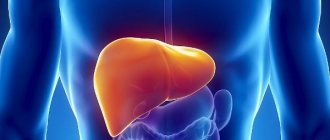Complexes with this research
Preparation for partner childbirth for a man Tests necessary to accompany a woman in labor RUB 3,680 Composition
Expanded hospital complex Expanded infectious screening for prevention and hospitalization RUB 7,700 Composition
Examination during pregnancy. 1st trimester 16,690 RUR Composition
IN OTHER COMPLEXES
- Entry into IVF RUB 23,020
- Future dad 8,460 RUR
- Pregnancy planning. Diagnosis of infections RUB 8,620
- Women's check-up No. 1 RUB 19,290
- Examination during pregnancy. 3rd trimester 9,620 RUR
Blood test for HCV
Taking a blood test for hcv is a laboratory detection of the hepatitis C virus. This disease attacks liver cells. As a rule, it can be transmitted through blood, during childbirth, or through sexual contact.
Indications for a blood test for HCV
Based on the results of the study, the analysis may be negative or positive. He is appointed:
- as prescribed by a doctor;
- with elevated levels of liver transaminases;
- with previous hepatitis;
- appointment of screening examinations;
due to symptoms of hepatitis C in the patient (body aches, causeless nausea, decreased appetite and weight, jaundice).
The hepatitis C virus can get worse during pregnancy and be dangerous to your health. In such cases, individual antiviral drug therapy is prescribed during the postpartum period.
When do you need to get tested for Hepatitis B, HBs Ag (quality)?
- Suspicion of infection with viral hepatitis B;
- Changes in liver biochemistry, indicating liver damage;
- Development of jaundice;
- Screening during pregnancy;
- Comprehensive examination before hospitalization;
- Pre-employment screening for specialists in certain professions (medical workers and others);
- Examination of people from groups at high risk of infection (receiving intravenous injections, undergoing hemodialysis, blood donors and others).
Indications for use
1. Increased levels of ALT and AST. 2. Clinical signs of acute or chronic viral hepatitis, chronic diseases of the liver and biliary tract. 3. Examination of foci of the disease in the family/team. 4. Preparation for vaccination. 5. Examination of chronic patients undergoing frequent parenteral procedures. 6. Preparation for hospitalization and surgery. 7. Pregnant women and in preparation for pregnancy. 8. Preventive examination of donors, people from risk groups (health workers, children from HBsAg carrier mothers). 9. Unprotected sexual intercourse, frequent change of sexual partners. 10. Intravenous drug addiction.
Detailed description of the study
Hepatitis B virus is a potentially life-threatening infection that affects the liver. The pathogen is found in body fluids such as blood, semen and vaginal secretions.
The main mechanisms of transmission of hepatitis B infection are as follows:
- Horizontal transmission - through unprotected sexual intercourse or contact with the mucous membranes of saliva, vaginal secretions, semen and blood of an infected person$
- Vertical transmission - from mother to newborn.
The incubation period of the disease lasts on average from 30 to 180 days. The virus penetrates the liver, where it attaches to the surface of the hepatocyte (liver cell) using the HBs antigen (HBsAg). Next, the virus penetrates the cell itself and begins replication, that is, reproduction. The human immune system identifies infected hepatocytes and secretes appropriate antibodies to proteins on the membrane, which ultimately causes cell destruction.
People infected with hepatitis B virus may have acute symptomatic illness or asymptomatic infection. Initial symptoms are nonspecific and may include:
- Flu-like condition (weakness, fever, aches in joints and muscles);
- Nausea or vomiting;
- Discomfort and pain in the right hypochondrium;
- Lack of appetite.
Jaundice may then occur. An infected person notices darkening of urine, discoloration of stool, and yellowing of the whites of the eyes and skin. Recovery is the usual outcome for people with normal immunity (about 95% of cases), but in a small number of people (5% on average) the disease can develop into chronic hepatitis B, which is defined as the presence of HBsAg for more than six months.
With chronic infection, people can experience both asymptomatic carriage and chronic hepatitis with possible progression to liver cirrhosis, when hepatocytes die and are replaced by tissue that is unable to perform the necessary functions. As a result, liver failure develops. Its signs are:
- Increase in abdominal volume due to fluid accumulation (ascites);
- Constant bloating, indigestion;
- Nausea, vomiting;
- Swelling of the legs;
- Dysfunction of the central nervous system (CNS);
- Jaundice;
- Increased body temperature;
- Decreased or lack of appetite;
- Sarcopenia is a decrease in the muscles of the arms and legs;
- Tendency to bruise;
- Bleeding gums;
- A rash on the body that looks like spider veins;
- Redness of the palms.
In case of severe liver failure, jaundice, impaired consciousness (encephalopathy), and gastrointestinal bleeding may develop. People who have been infected with hepatitis B for a long time have an increased risk of hepatocellular carcinoma - liver cancer.
Diagnosis is based on blood tests in people with symptoms and associated risk factors for the disease. Detection of HBsAg serves as the basis for the primary diagnosis of viral hepatitis B. Its appearance in the blood is observed at the end of the incubation period of the disease and persists in the chronic form of the infection.
Interpretation:
- Positive result: acute hepatitis B (incubation or acute periods), carriage of the hepatitis B virus, chronic hepatitis B.
- Negative result: hepatitis B is not detected (in the absence of other markers of hepatitis B). Note. In the presence of a negative result, it is impossible to exclude acute hepatitis B during the recovery period, chronic hepatitis B with low replication intensity, fulminant, malignant course of HBV, hepatitis B with a defective (seronegative) HBs antigen, mixed hepatitis B+D (delta virus uses surface antigen as its shell, so it may not be detected).
Sample result (PDF)
References
- Ivashkin, V.T., Mayevskaya, M.V., Pavlov, Ch.S. and others. Clinical recommendations of the Russian Society for the Study of the Liver and the Russian Gastroenterological Association for the treatment of complications of liver cirrhosis. - Russian Journal of Gastroenterology, Hepatology, Coloproctology, 2021. - V. 26(4). — P. 71-102.
- Schwarz, W., Heidi, M., Nancy, E. False positive hepatitis B surface antigen test caused by hepatitis B vaccine, The Pediatric Infectious Disease Journal, 2001. - Vol. 8(2). — P. 189-193.
- Tripathi, N., Mousa, O. Hepatitis B. - In: StatPearls, 2020.
- Anjum, Q. False positive Hepatitis B Surface Antigen due to recent vaccination. - IntJHealthSci (Qassim), 2014. - Vol. 8(2). — P. 189-193.
Journal "Laboratory" No. 4, 2012, pp. 23-24
Balubash V.V.
Alkor Bio LLC, St. Petersburg
There are approximately 2 billion people worldwide infected with hepatitis B virus (HBV), of whom more than 350 million have chronic infection. Hepatitis B kills between 500,000 and 700,000 people each year [1]. In Russia, thanks to the inclusion of vaccination against hepatitis B in the national calendar of preventive vaccinations, improving the quality of test systems for screening studies, and a set of measures to improve the safety of blood transfusions and its components, the incidence of acute hepatitis B (AHB) has shown a downward trend in recent years. However, chronic hepatitis B (CHB), which is registered in 5-10% of cases in adults, and with perinatal infection of newborns is formed in 80-90% of cases, still poses a serious problem. CHB is dangerous due to its consequences: it is one of the main causes of liver cirrhosis and the main cause of hepatocellular carcinoma. Liver cirrhosis develops after 10-20 years in 15-40% of patients suffering from CHB. The incidence of liver cancer ranges from 2 to 8 cases per 100 patients with cirrhosis per year. CHB requires expensive therapy using etiotropic drugs. According to European guidelines, the goal of treatment is to improve the quality and length of life by preventing progression of the disease to decompensated cirrhosis and hepatocellular carcinoma through sustained suppression of viral replication. Currently, the following groups of drugs are used for etiotropic therapy: standard alpha interferons, nucleoside analogues and pegylated interferons.
The main method for screening diagnosis of hepatitis B is the determination of HBsAg. Being the main component of the outer shell of the virus, it is detected in infected hepatocytes, in blood and other biological fluids. HBsAg is a complex protein with several immunodominant regions, among which there is a group-specific determinant “a” and subgroup determinants (“y” or “d”, “r” or “w”). Various combinations of antigenic determinants form virus subtypes. Surface antigen appears already during the incubation period, usually 2-3 weeks after infection. Subsequently, the concentration of HBsAg increases along with an increase in ALT activity. [2]. HBsAg is synthesized in the cytoplasm of hepatocytes. Only part of this protein is used to build new viral particles, but the main amount of HBsAg enters the blood of infected individuals in the form of spherical particles with a diameter of 22 nm and rod-shaped particles up to 200 nm in length. The number of such particles in the blood exceeds the number of infectious HBV virions by tens and hundreds of thousands of times. The concentration of HBsAg in the blood during acute and chronic HBV infection varies widely - from 0.1 ng/ml to 1.0 mg/ml. Back in the 80s of the last century, a correlation was noted between the HBsAg titer, the presence in the blood serum of HBeAg associated with viral reproduction and the severity of pathological changes in liver tissue [3]. Further study of HBsAg showed that, when quantified, it can serve as a marker to predict the course of the disease.
Today, quantitative determination of HBsAg can be used not only to monitor the course of chronic hepatitis B, but also as an additional marker for assessing the viral response to etiotropic therapy. In 2009, the journal Hepatology published the work of Moucari et al. [5], which showed the role of quantitative determination of HBsAg in blood serum for predicting the virological response of patients to antiviral therapy. The research methods used were HBV genotyping, HBV DNA quantification, and serum HBsAg quantification. The study included patients with HBeAg-negative CHB. Treatment was carried out with pegylated interferon-alpha for 48 weeks. All studies were performed before the start of treatment, as well as at the 12th, 24th and 48th weeks of therapy and during the follow-up period at 72nd and 96th weeks.
Based on the determination of the amount of HBV DNA, the difference between the groups of patients who responded and did not respond to treatment begins to be determined from the 12th week, and only by the 24th week can the group of patients in whom the therapy is ineffective be correctly identified. For patients who relapsed, they could not be identified based on HBV DNA until the end of treatment.
Based on the quantitative determination of HBsAg, already by the 12th week of treatment it was possible to identify a group of patients who did not respond to therapy, as well as patients with relapse, which makes it possible to adjust treatment in the early stages. For example, nucleoside analogues can replace or supplement existing antiviral therapy prescriptions.
In a study by Piratvisuth T. et al. [6] against the background of 48-week therapy with pegylated interferons in HBeAg-positive CHB patients, the rate of HBeAg seroconversion had an inverse relationship with the level of HBsAg. When the HBsAg concentration was less than 1500 IU/ml at week 12 of HBeAg therapy, seroconversion was observed in 57% of patients, and at week 24 – in 54%. At HBsAg levels of 1500–20,000 IU/ml HBeAg, seroconversion was detected in 32% at week 12 of treatment, and in 26% at week 24. HBsAg levels greater than 20,000 IU/ml at weeks 12 and 24 predicted HBeAg seroconversion in only 16% and 15% of patients, respectively.
Currently, quantitative measurement of HBsAg in blood serum is becoming more common and accessible in our country. Along with expensive chemiluminescent systems that require special equipment for their use, the HepatitELISA-HBsAg test system has appeared for enzyme-linked immunosorbent determination of the amount of surface antigen. This test system can be used both for the qualitative determination of HBsAg (for screening studies), and for monitoring treatment and in-depth study of the natural course of hepatitis B.
Clinical trials of the diagnostic system took place at the Pasteur Research Institute of Epidemiology and Microbiology, St. Petersburg. The studies assessed the sensitivity and specificity of the HepatitELISA-HBsAg kit. The analysis involved 80 positive (containing HBsAg) and 80 negative (not containing HBsAg) sera. The samples were obtained during the examination of patients with various forms of hepatitis B. As part of the clinical trials, the performance of the kit was compared with the ARCHITECT HBsAg test system for the quantitative determination of HBsAg using chemiluminescent analysis (CHLA) manufactured by Abbott Laboratories (USA). Analysis of the data obtained showed complete agreement with the results of the qualitative analysis, i.e. 100% sensitivity and specificity of the Alkor Bio kit.
When comparing data on the quantitative level of HBsAg in the studied samples, the comparability of the indicators obtained in the HepatitIFA-HbsAg test system produced by Alkor Bio and the reference kit was noted. The correlation coefficient was r = 0.99. As an example, Table 1 shows the results of quantitative assessment of HbsAg in low-titer samples of the test panel [7].
Table No. 1.
Results of measuring the quantitative content of HbsAg in samples of the test panel of sera with low antigen content
| Sample No. | HbsAg concentration in IU/ml | |
| ARCHITECT HbsAg (Abbott Laboratories) | HepatitisELISA-HbsAg (Alkor Bio) | |
| 83 | 34,9 | 42,0 |
| 91 | 0,98 | 1,2 |
| 98 | 14,3 | 17,0 |
| 101 | 58,0 | 65,0 |
| 102 | 33,0 | 29,0 |
| 107 | 16,0 | 16,0 |
| 109 | 16,6 | 18,0 |
| 119 | 10,1 | 8,0 |
The results of clinical trials allow us to conclude that “HepatitELISA-HBsAg” is highly sensitive and specific and recommend the kit for widespread use in laboratory practice, not only for qualitative, but, importantly, for quantitative determination of HBsAg.
Conclusion
Quantitative determination of HBsAg in patients with viral hepatitis B is an important characteristic for predicting the natural history of infection and assessing the effectiveness of antiviral therapy. The possible role of the marker in determining the final duration of therapy in CHB patients receiving nucleoside analogues deserves great attention. The HepatitELISA-HBsAg kit is recommended as a test system for the quantitative determination of HBsAg, which has shown in clinical trials 100% sensitivity and specificity for detecting HBV in serum blood, as well as a high correlation coefficient with the data of the chemiluminescence method. The HepatitIFA-HBsAg kit produced by Alkor Bio can be used both for conducting mass screening studies for the qualitative detection of HBsAg, and for monitoring the natural course of chronic hepatitis B and the effectiveness of therapy, which is based on the quantitative determination of HBsAg.
Bibliography
1. WHO, Sixty-third World Health Assembly, Viral hepatitis, Report of the Secretariat. — 2010 - p.1
2. Onishchenko G.G., Zherbun A.B. Viral hepatitis in the Russian Federation St. Petersburg: NIIEM im. Pasteur, 2009 - With. 63
3. Mukomolov S.L. Epidemiological and clinical and laboratory characteristics of chronic HBsAg carriers depending on the severity of the pathological process.// Abstract of thesis. diss. Ph.D. honey. Sciences L. 1984. – p. 24
- Jaroszewicz J., Calle Serrano B., Wursthorn K. et al. Hepatitis B surface antigen (HBsAg) levels in the natural history of hepatitis B virus (HBV) – infection: a European perspective.// J. Hepatol. – 2010. – vol.52, N4. – p.514-522). Arauz-Ruiz P, Norder H, Robertson BH, Magnius LO. Genotype H: a new Amerindian genotype of hepatitis B virus revealed in Central America /J. Gen. Virol. 2002.- No. 83(Pt 8).-r.2059-2073.
- Brunetto MR et al. Predicting Response to hepatitis B virus therapy. Hepatology 2009; 49:1141. Moucari, R.
6. Piratvisuth, T. On-treatment decline in serum HBsAg levels predicts sustained immune control 6 months posttreatment and subsequent HBsAg clearance in HBeAg-positive hepatitis B virus-infected patients treated with peginterferon alfa-2a [40KD] (PEGASYS) / T. Piratvisuth//Hepatol Int. – 2010. – V. 4. – P. 152, abstract PP211.
- Mukomolov S.L., Ivanova N.V. and others. New possibilities for the quantitative determination of the surface antigen of the hepatitis B virus (HBsAg) in serum and blood plasma using a Russian-made test system.. Directory of the head of the CDL. No. 8, August 2011, p. 40-44
general characteristics
Anti-HBs antibodies appear in the recovery phase after acute hepatitis B, usually 3 to 4 months after the elimination of HBsAg, the so-called. “window” phase (can vary from 1 month to 1 year depending on the state of the patient’s immune system). During this window period, it is important to screen the patient for anti-HBcor IgM. Anti-HBs antibodies are especially important in providing immune protection against this virus, so quantitative determination of anti-HBs antibodies is usually used to monitor the effectiveness of immunity during vaccination against hepatitis B. Over time, the antibody titer decreases until undetectable. Lifelong circulation of anti-HBs antibodies is sometimes possible. The appearance of anti-HBs against the background of clinical improvement in a patient with hepatitis B and the disappearance of HBsAg is a good prognostic sign and indicator of recovery. In the chronic course of hepatitis B, parallel determination of the surface antigen and antibodies to it is possible. The detection of anti-HBs in the acute phase of hepatitis B in parallel with HBsAg indicates an unfavorable prognosis of the disease. Chronic course occurs in 5% of cases. “Healthy carriers” of HBsAg, as well as patients with chronic hepatitis B, are at high risk of developing liver cirrhosis and hepatocellular carcinoma. Systemic manifestations do not always disappear when hepatitis B is cured.








